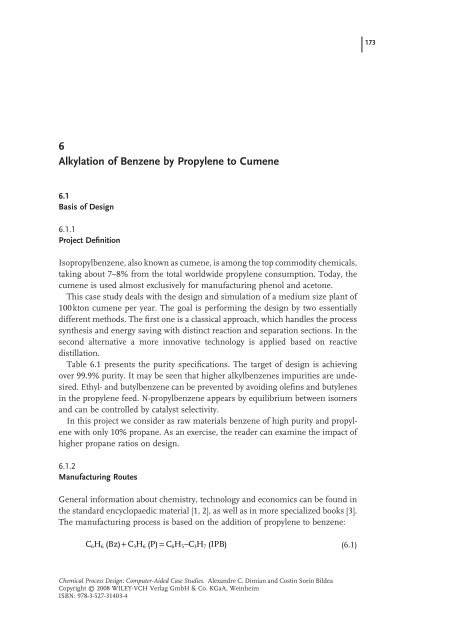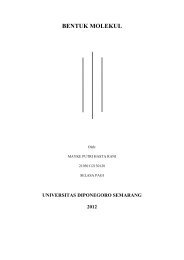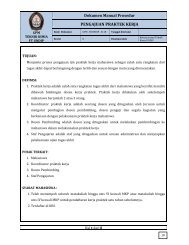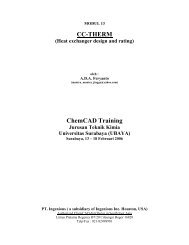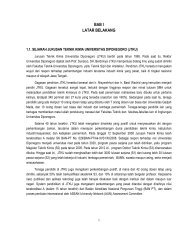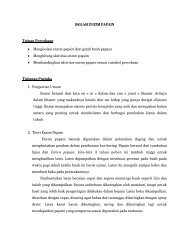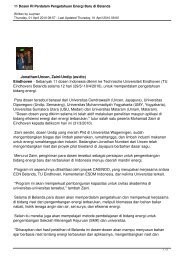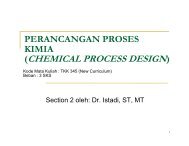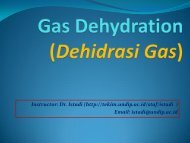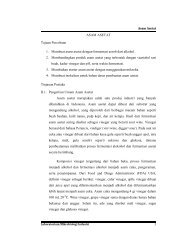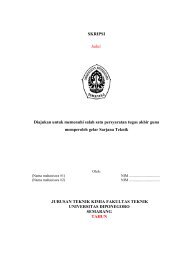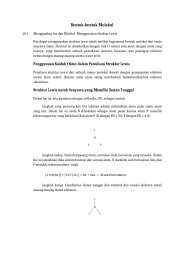Alkylation of Benzene by Propylene to Cumene 6
Alkylation of Benzene by Propylene to Cumene 6
Alkylation of Benzene by Propylene to Cumene 6
- No tags were found...
Create successful ePaper yourself
Turn your PDF publications into a flip-book with our unique Google optimized e-Paper software.
6.2 Reaction-Engineering Analysis 177Transalkylation(ii)(iii)Polyalkylation(iv)Secondary isomerization(v)Dimerization(vi)
178 6 <strong>Alkylation</strong> <strong>of</strong> <strong>Benzene</strong> <strong>by</strong> <strong>Propylene</strong> <strong>to</strong> <strong>Cumene</strong>Other side reactions(vii)6.2.2Catalysts for the <strong>Alkylation</strong> <strong>of</strong> AromaticsIn general, the alkylation <strong>of</strong> aromatics is dominated <strong>to</strong>day <strong>by</strong> liquid - phase processesbased on zeolites. The term “ zeolitic ” refers <strong>to</strong> molecular sieves whoseframework consists essentially <strong>of</strong> silica and alumina tetrahedra. The complexity<strong>of</strong> tetrahedral groups may be linked in polynuclear structures. Five types <strong>of</strong> zeolitesare the most applied: beta, Y, ZSM - 12, MCM - 22 and mordenite [5, 6] . These catalystsare characterized <strong>by</strong> large pore opening necessary for achieving high selectivity.As an illustration, Figure 6.2 shows the spatial structure <strong>of</strong> a beta - zeolite. Boththe specific three - dimensional structure and the chemical composition, includingthe presence <strong>of</strong> doping elements, lead <strong>to</strong> substantial differences in activity andselectivity. The catalytic properties depend strongly on the surface treatment andon the activation procedure.Since industrial catalysts are employed as pellets, the mass - and heat - transfereffects can play an important role. The internal diffusion is <strong>of</strong>ten the critical stepcontrolling the overall process rate. The use <strong>of</strong> an efficient catalyst is the decisiveelement in designing a competitive process.Table 6.5 presents some global yield data, including transalkylation. Zeolite - betais <strong>of</strong>ten mentioned among the best suited for fixed - bed operation, with selectivityFigure 6.2 Spatial structure <strong>of</strong> beta - zeolite.
6.2 Reaction-Engineering Analysis 179Table 6.5 Selectivity obtained with different zeolite catalysts in cumene synthesis [4] .Zeolite - beta Mordenite MCM - 22 Zeolite - YOverall selectivity on propylene (%) 99.87 98.61 98.74 98.30Table 6.6 Selectivity and DIPB distribution at different temperatureand propylene conversions [6] .Catalyst T ( ° C) X propylene a)(%)b)Selectivity (%) Iso/n DIPBs distribution (%)ratio<strong>Cumene</strong> DIPB Oligo ortho meta paraMCM – 22 180 76.05 92.12 7.34 0.32 1650 10 30 6097.97 90.56 9.03 0.27 830 8 32 60220 91.70 90.78 8.84 0.18 790 7 33 6096.28 89.54 9.60 0.11 460 5 38 57Beta 180 76.25 92.16 6.96 0.41 920 6 42 5297.34 90.76 8.33 0.25 900 5 44 51220 89.90 89.34 10.07 0.21 720 5 46 4998.34 88.67 10.58 0.15 460 3 51 46Reactions conditions: <strong>to</strong>tal pressure, 3.5 MPa; B/P mole ratio, 7.2. Catalyst with Si/Al ratio about 16.a) Different propylene conversion were achieved <strong>by</strong> changing the WHSV.b) Selectivity referred <strong>to</strong> propylene.in cumene around 90%. Other studies prefer MCM - 22 because <strong>of</strong> better stabilityagainst deactivation [7] . As Table 6.6 shows, the selectivities <strong>of</strong> zeolite - beta andMCM - 22 are similar in the range <strong>of</strong> temperature <strong>of</strong> 180 – 220 ° C and benzene/propyleneratios <strong>of</strong> 3.5 – 7.2. Modified Y - type zeolites were found capable <strong>of</strong> selectivityover 97% at lower temperature [8] , and are therefore recommended for catalyticdistillation. Recent patents show that the new superactive zeolite catalysts are suitablefor both alkylation and transalkylation reactions.At quasiequal selectivity the differences in performance <strong>of</strong> catalysts can be justified<strong>by</strong> the amount <strong>of</strong> trace impurities produced. Because operating at lower temperatureis more favorable, material efficiency seems <strong>to</strong> be in contradiction withheat integration.Table 6.7 displays some physical properties <strong>of</strong> zeolites. A study issued fromindustry [8] demonstrates the significant role <strong>of</strong> mass - transfer resistances, evenfor small particles below 1 mm, reporting that pore diffusion may decrease theeffectiveness from low <strong>to</strong> very low values (0.4 <strong>to</strong> 0.06). The external mass - transferresistance is much less important. In consequence, in commercial operation onlya small part <strong>of</strong> the catalyst is effectively used, typically less than 10%. Since the
180 6 <strong>Alkylation</strong> <strong>of</strong> <strong>Benzene</strong> <strong>by</strong> <strong>Propylene</strong> <strong>to</strong> <strong>Cumene</strong>Table 6.7 Physical properties <strong>of</strong> a zeolite catalyst.Surface area, m 2 /g 500 – 800 Particle size Extrudates 1.6 – 2.4 × 4 – 10 mmParticle porosity 0.5 Void fraction 0.35 – 0.43Particle density, kg/m 1000 Tortuosity 5reduction <strong>of</strong> particle size is restricted in practice for technological reasons, anotheralternative is the use <strong>of</strong> a surface - coated monolith catalyst. However, high exothermicityraises problems with respect <strong>to</strong> temperature control. In conclusion, thesubtle combination <strong>of</strong> chemical and physical fac<strong>to</strong>rs leads <strong>to</strong> a large variability inthe behavior <strong>of</strong> the commercial catalysts with respect <strong>to</strong> reaction rate andselectivity.6.2.3Thermal EffectsA critical issue in reac<strong>to</strong>r design is exploiting at best the high exothermicity <strong>of</strong> thealkylation reaction. Note that the thermal effect corresponds roughly <strong>to</strong> the evaporation<strong>of</strong> 3.67 moles benzene. A measure <strong>of</strong> exothermicity is the adiabatic temperaturerise illustrated in Figure 6.3 as a function <strong>of</strong> the molar ratio benzene/propylenewith the inlet temperature as a parameter. Higher dilution with benzene can makeit fall significantly, from 120 ° C <strong>to</strong> less than 60 ° C; the inlet temperature plays aminor role. On the other hand, higher benzene/propylene ratio gives better selectivity,but increases the cost <strong>of</strong> separations. As a result, the ratio benzene/propyleneis a key optimization variable.Other measures for better temperature control could be employed, such asa series <strong>of</strong> reac<strong>to</strong>rs with intermediate cooling, or injection <strong>of</strong> a cold inert. Thesimulation shows that these methods have no significant effects on the overallyields, although they may <strong>of</strong>fer a better protection <strong>of</strong> the catalyst in long - timeoperation.Figure 6.3 Adiabatic temperature rise as a function <strong>of</strong> thereactant ratio and inlet reac<strong>to</strong>r temperature.
6.2 Reaction-Engineering Analysis 181Figure 6.4 The variation <strong>of</strong> selectivity with the molar ratio benzene/propylene.6.2.4Chemical EquilibriumChemical equilibrium indicates that more than 99% conversion <strong>of</strong> propylene maybe achieved for benzene/propylene ratios larger than three. However, the selectivityremains a problem. Figure 6.4 shows the variation <strong>of</strong> selectivity defined ascumene formed per mole <strong>of</strong> propylene, when only di - isopropylbenzene is the<strong>by</strong>product. Increasing the ratio from 3 <strong>to</strong> 9 moles gives a significant selectivityimprovement from 82% <strong>to</strong> over 92%. From this point <strong>of</strong> view the performance <strong>of</strong>beta - zeolites reported in Table 6.6 seems <strong>to</strong> achieve its thermodynamic limit.Higher temperature is beneficial for getting higher yield, but the effect islimited.6.2.5KineticsThe examination <strong>of</strong> patents reveals that the operation conditions for the alkylation<strong>of</strong> benzene with propylene are temperatures between 150 and 230 ° C and pressuresbetween 25 and 35 bar. The catalyst productivity expressed as WHSV is in therange 1 – 10 (based on the reaction mixture) at benzene/propylene molar ratiosranging from 5 <strong>to</strong> 8.As mentioned, from the reaction kinetics viewpoint the behavior <strong>of</strong> zeolite catalystsshows large variability. In addition, the apparent kinetics can be affected <strong>by</strong>pore diffusion. The compilation <strong>of</strong> literature revealed some kinetic equations, buttheir applicability in a realistic design was questionable. In this section we illustratean approach that combines purely chemical reaction data with the evaluation<strong>of</strong> mass - transfer resistances. The source <strong>of</strong> kinetic data is a paper published <strong>by</strong>Corma et al. [7] dealing with MCM - 22 and beta - zeolites. The alkylation takes placein a down - flow liquid - phase microreac<strong>to</strong>r charged with catalyst diluted with carborundum.The particles are small (0.25 – 0.40 mm) and as a result there are nodiffusion and mass - transfer limitations.
182 6 <strong>Alkylation</strong> <strong>of</strong> <strong>Benzene</strong> <strong>by</strong> <strong>Propylene</strong> <strong>to</strong> <strong>Cumene</strong>The surface chemical reaction seems <strong>to</strong> follow the Eley – Rideal (ER) mechanism,in which the adsorption <strong>of</strong> propylene is predominant over benzene, as represented<strong>by</strong> the equation:rAkK 0 PcP=1 + KcP P(6.2)in whick k 0 is the surface reaction constant, K P the adsorption constant <strong>of</strong> propylene,and c P its the bulk propylene concentration. The mentioned reference suppliesexperimental values for k 1 = k 0 K P but not for K P . Because on the interval <strong>of</strong> interestK P c P
6.3 Reac<strong>to</strong>r/Separa<strong>to</strong>r/Recycle Structure 183k1 = 6510exp( −52564/ RT) (6.5)in which the reaction rate is given in kmol/m 3 .s and the activation energy in kJ/kmol. Table 6.6 enables an estimation <strong>of</strong> a first - order reaction constant for theDIPB formation as:k2 = 450exp( −55000/ RT) (6.6)The above kinetic equations have been tested <strong>by</strong> the simulation <strong>of</strong> an adiabaticPFR. For an inlet temperature <strong>of</strong> 160 ° C, a benzene/propylene ratio <strong>of</strong> 7 and aspatial time WHSV <strong>of</strong> 10 a <strong>to</strong>tal conversion <strong>of</strong> propylene may be reached withselectivity around 90%. In conclusion, the kinetic data corresponds <strong>to</strong> a fast industrialcatalyst and may be reasonably used in design.6.3Reac<strong>to</strong>r/Separa<strong>to</strong>r/Recycle StructureThe following reac<strong>to</strong>r performance in recycle is the aim: over 99.9% per/passpropylene conversion over 88% cumene selectivity, adiabatic temperature risebelow 70 ° C, but a maximum catalyst temperature <strong>of</strong> 250 ° C. The inlet pressureshould be sufficiently high <strong>to</strong> ensure only one liquid phase. Thermodynamic calculationsat 35 bar indicate bubble temperatures <strong>of</strong> 198 and 213 ° C for propylene/benzene ratios <strong>of</strong> 1/4 and 1/7, respectively (Figure 6.5 ). The reactive mixture canbe maintained as liquid up <strong>to</strong> about 250 ° C, since the concentration <strong>of</strong> propylenediminishes gradually <strong>by</strong> reaction.In a first attempt, we simulate the reac<strong>to</strong>r as an adiabatic PFR. We consider adiameter <strong>of</strong> 1.3 m and a <strong>to</strong>tal length <strong>of</strong> 7 m, which ensure propylene conversionover 99.9%. The feed consists <strong>of</strong> 100 kmol/h propylene at molar benzene/Figure 6.5 Reac<strong>to</strong>r residence time as a function <strong>of</strong> the molar benzene/propylene ratio.
184 6 <strong>Alkylation</strong> <strong>of</strong> <strong>Benzene</strong> <strong>by</strong> <strong>Propylene</strong> <strong>to</strong> <strong>Cumene</strong>Table 6.9 The performance <strong>of</strong> an adiabatic PFR function <strong>of</strong>inlet temperature and excess <strong>of</strong> benzene.B/P ratio 160 ° C 170 ° C 180 ° CT out S T out S T out S4 267.7 0.8117 276.0 0.8167 280.9 0.82155 250.8 0.8403 258.7 0.8451 266.5 0.84966 238.4 0.8608 246.7 0.8654 254.9 0.86977 228.8 0.8755 237.5 0.8807 246.9 0.88478 218.9 0.8542 230.2 0.8926 238.9 0.8966Figure 6.6 Pr<strong>of</strong>i le <strong>of</strong> concentrations and temperature in anadiabatic PFR for cumene synthesis.propylene ratios between 4 and 8. The inlet temperature varies between 160 and180 ° C. The reaction mixture may circulate downwards or upwards.The results <strong>of</strong> reac<strong>to</strong>r simulation are presented in Table 6.9 and in Figure 6.6 .It may be observed that the larger the benzene excess the better the selectivity.Higher inlet temperature is favorable <strong>to</strong>o, but the effect is limited. A larger excess<strong>of</strong> benzene can limit the adiabatic temperature rise from 100 ° C <strong>to</strong> less than 60 ° C.Other options are possible, such as a series <strong>of</strong> reac<strong>to</strong>rs with intercooling, partialcold feed <strong>of</strong> reactants, or internal heat exchangers, but we did not find a substantialadvantage over a single - bed adiabatic reac<strong>to</strong>r. For example, a series <strong>of</strong> two adiabaticreac<strong>to</strong>rs with intercooling gives a minimum amount <strong>of</strong> DIPB <strong>by</strong> splitting the propylenein the ratio 3:1, but the effect is small with an excessive temperature risein the first reac<strong>to</strong>r.To simplify the analysis, we make use <strong>of</strong> a single adiabatic reac<strong>to</strong>r. The sizingelements given before ensure the desired production rate. Figure 6.6 displaysconcentration and temperature pr<strong>of</strong>iles for an inlet temperature <strong>of</strong> 170 ° C and abenzene/propylene ratio <strong>of</strong> 7. The above kinetic model gives per - pass selectivity
6.4 Mass Balance and Simulation 185<strong>of</strong> propylene <strong>to</strong> cumene <strong>of</strong> about 88%, in good agreement with the experimentaldata for MCM - 22 and beta - zeolite [7] , as well as a reasonable amount <strong>of</strong> DIPBs.The formation <strong>of</strong> secondary products reaches a plateau <strong>to</strong>ward the exit <strong>of</strong> thereac<strong>to</strong>r. The DIPB ’ s distribution is about 5% ortho, 40% meta and 55% para, withless than 0.3% oligomers. Dividing the <strong>to</strong>tal throughput <strong>by</strong> the amount <strong>of</strong> catalystgives a weight hourly space velocity (WHSV) <strong>of</strong> 11, or a residence time <strong>of</strong> 5 min.These values are in good agreement with the industrial practice.To increase the overall yield, the DIPB is reconverted <strong>to</strong> cumene in a transalkylationreac<strong>to</strong>r in the presence <strong>of</strong> a large excess <strong>of</strong> benzene. The same zeolite catalystmay be used. Practical data for the design are temperatures <strong>of</strong> 140 – 150 ° C, benzene/DIPB ratios between 20 – 30 and a WHSV <strong>of</strong> 2 <strong>to</strong> 3.6.4Mass Balance and SimulationAt the reac<strong>to</strong>r outlet the reaction mixture has a temperature <strong>of</strong> 230 ° C and a pressure<strong>of</strong> 34 bar, the molar composition being 86.6% benzene, 12.6% cumene and0.8% DIPB. Other components are lights , in this case the propane entered withthe feed, and heavies , lumped as tri - propylbenzene.By examining a list <strong>of</strong> physical properties in Table 6.4 , it can be seen that thefreezing point cannot be exploited for separations. The relatively wide boilingpoints show good opportunities for separations <strong>by</strong> distillation. Note that if hexeneforms <strong>by</strong> propane dimerization it will accumulate in the benzene recycle loopbecause its removal is very difficult.Because <strong>of</strong> the quasi - ideal VLE <strong>of</strong> binary mixtures, the boiling points <strong>of</strong> componentssuggests the sequencing <strong>of</strong> separations. Following the heuristics in Chapter3 the removal <strong>of</strong> lights has <strong>to</strong> be done in the first place. The first separation (C - 1)is the depropanizer column. The pressure is selected so as <strong>to</strong> ensure the condensation<strong>of</strong> the <strong>to</strong>p product <strong>by</strong> air cooling. Next, follows the separation <strong>of</strong> the ternarymixture benzene/IPB/DIPB. Because <strong>of</strong> the large benzene amount the “ directsequence ” is the best choice. The recovery <strong>of</strong> benzene takes place in the column(C - 2). If follows the separation cumene/DIPB in the column (C - 3), this time operatedunder vacuum and constrained <strong>by</strong> the reboiler temperature. DIPB recoveredfrom heavies in the vacuum distillation column (C - 4) is sent <strong>to</strong> the transalkylation,<strong>to</strong>gether with an appropriate amount <strong>of</strong> recycled benzene. It may be seen that theabove flowsheet is the same as the technology displayed in Figure 6.1 . The simulationfollows the flowsheet in Figure 6.7 .The design <strong>of</strong> the distillation columns deserves some comment. A pressure <strong>of</strong>12 bar is convenient for (C - 1) because it gives a bot<strong>to</strong>ms temperature below 200 ° Cand a condenser temperature <strong>of</strong> 34 ° C. The design should prevent loss <strong>of</strong> benzenein the <strong>to</strong>p product, which is used as GPL fuel. The feed temperature is kept a<strong>to</strong>ptimum, <strong>by</strong> trading the hot utility consumption against recovery. Note that inthis case the shortcut predesign <strong>by</strong> Underwood – Gilliland is very different fromthe rating design <strong>by</strong> Radfrac. The following configuration ensures a high recovery
186 6 <strong>Alkylation</strong> <strong>of</strong> <strong>Benzene</strong> <strong>by</strong> <strong>Propylene</strong> <strong>to</strong> <strong>Cumene</strong>Figure 6.7 Process - simulation diagram for the alkylation <strong>of</strong> propylene with benzene.
6.5 Energy Integration 187<strong>of</strong> propane with less than 100 ppm benzene: 16 theoretical stages with feed on 5and a temperature <strong>of</strong> 150 ° C, and a reflux <strong>of</strong> 4300 kg/h.The recycle column (C - 2) is characterized <strong>by</strong> a very large distillate/feed ratio.Therefore, the design should minimize the reboiler duty. In addition, the pressureshould be low enough <strong>to</strong> avoid excessive reboiler temperature. High recovery <strong>of</strong>benzene in <strong>to</strong>p is desirable (over 99.9%) but small amounts <strong>of</strong> cumene are <strong>to</strong>lerated.In a first attempt we consider a column <strong>of</strong> 25 stages operated at atmosphericpressure, with feed location in the middle and a reflux ratio <strong>of</strong> 0.26.The column (C - 3) for cumene distillation operates under vacuum <strong>to</strong> avoid anexcessive bot<strong>to</strong>m temperature. A number <strong>of</strong> 30 stages and a reflux ratio <strong>of</strong> 1.2 aresufficient <strong>to</strong> ensure good - purity cumene with less than 100 ppm benzene.In order <strong>to</strong> focus on the main issues <strong>of</strong> process integration, we disregard thedistillation column for heavies, as well as the transalkylation section. A preliminarysimulated flowsheet in Aspen Plus [9] is shown in Figure 6.8 , with values <strong>of</strong> temperatures,pressures and heat duties. The fresh feed <strong>of</strong> propylene is 110 kmol/h.Note that design specifications are used for the fine tuning <strong>of</strong> the simulation blocks.The fresh benzene is added in the recycle loop as makeup stream so as <strong>to</strong> keepthe recycle flow rate constant. This approach makes the convergence easier.6.5Energy IntegrationBased on the preliminary flowsheet a table <strong>of</strong> streams for heat integration are built(Table 6.10 ). On this basis a pinch - point analysis can be done <strong>by</strong> using a specializeds<strong>of</strong>tware, such as SuperTarget [10] . In this way, targets for energy <strong>by</strong> can bedetermined for ∆ T min <strong>of</strong> 10 ° C, as shown in Figure 6.8 . The minimum energyrequirements are Q h = 9143.4 kW and Q c = 11 063.9 kW. By taking advantage onlyfrom process/process heat exchange a saving in heat up <strong>to</strong> 43% in hot utility and40% in cold utility can be achieved. Since the reaction is highly exothermal, weexpect possible export <strong>of</strong> energy <strong>to</strong>o.Table 6.10 Hot and cold stream table.Cold streamsHot streamsName T s ( ° C) T t ( ° C) Duty (kW) Name T s ( ° C) T t ( ° C) Duty (kW)Reac<strong>to</strong>r_in 72 170 3 657.5 Reac<strong>to</strong>r_out 236.6 150.0 − 3 781.4Feed_C - 2 197.9 90.0 − 4 116.9Reb_C - 1 198.9 197.9 2 318.1 Cond_C - 1 36.3 35.3 − 399.1Reb_C - 2 162.1 163.1 7 870.8 Cond_C - 2 83.4 82.4 − 7 572.9Reb_C - 3 161.1 162.1 1 979.6 Cond_C - 3 99.3 98.3 − 2 413.6Total 15 826.6 − 18 283.9
188 6 <strong>Alkylation</strong> <strong>of</strong> <strong>Benzene</strong> <strong>by</strong> <strong>Propylene</strong> <strong>to</strong> <strong>Cumene</strong>Figure 6.8 Composite curves (left) and grand compositecurves (right) in the preliminary analysis.The examination <strong>of</strong> composite curves indicates that the pinch is situated betweenthe reac<strong>to</strong>r and the benzene column. The largest energy consumer is <strong>by</strong> far thebenzene column, with reboiler and condenser duties <strong>of</strong> more than 7.5 MW. Byexchange between the reac<strong>to</strong>r outlet and inlet streams considerable energy issaved, but only a modest amount <strong>of</strong> about 1 MW can be used for steam generation.The target temperatures <strong>of</strong> the hot streams (condensers) <strong>of</strong> the columns C - 2 andC - 3 show that most <strong>of</strong> the energy is rejected in the environment, at a temperatureslightly below 100 ° C. In consequence, a first design modification is suggested:raise the pressure in columns so as <strong>to</strong> recover the energy <strong>of</strong> condensation in amore useful form, such as low - pressure steam. On the other hand, since the temperaturedifference <strong>to</strong>p – bot<strong>to</strong>m is large (about 80 ° C) the hot - utility temperature
6.5 Energy Integration 189Figure 6.9 Energy saving <strong>by</strong> multieffect distillation:(a) standard arrangement, (b) sloppy split <strong>of</strong> heavy component,(c) sloppy split <strong>of</strong> light component.for driving the reboiler will set a hard constraint on the maximum column pressure.Obviously, the reflux and feed temperature <strong>of</strong> the columns have <strong>to</strong> beoptimized.In the following, we focus the attention on energy saving for the benzene recyclecolumn. Since the separation regards essentially a binary mixture with very largedistillate/bot<strong>to</strong>ms ratio, the analogy with multieffect evaporation seems rational.Accordingly, we split the original feed in<strong>to</strong> two parts for two columns in parallel,operated at high and low pressure, respectively. In addition, the temperature <strong>of</strong><strong>to</strong>p and bot<strong>to</strong>m may be manipulated <strong>by</strong> the product composition. By this approach,called multieffect distillation, three possibilities <strong>of</strong> heat integration could be imagined,as illustrated in Figure 6.9 .In alternative (a) pure products are obtained in each column. Since the relativevolatility diminishes with the pressure, higher reflux is needed in the HP column.The balance <strong>of</strong> duties can be obtained <strong>by</strong> adjusting the split <strong>of</strong> the feed. Roughlyspeaking, <strong>by</strong> double - effect distillation the energy consumption is divided <strong>by</strong> two.In alternative (b) there is a large temperature difference between <strong>to</strong>p and bot<strong>to</strong>mthat may be exploited <strong>by</strong> a sloppy split in the HP column with the heavy component,while in alternative (c) this is done with the light component. Alternative (c)is the best for the present case study since it allows a lower temperature <strong>of</strong> the hotutility.The modified flowsheet is presented in Figure 6.10 : the low - pressure column(C - 2A) operates at 3 bar, while the high - pressure column (C - 2B) operates at 8 bar.Note that the bot<strong>to</strong>m stream <strong>of</strong> (C - 2B) may contain an important amount <strong>of</strong>benzene. The examination <strong>of</strong> the pr<strong>of</strong>iles shows an imbalance in vapor flow in thelower part <strong>of</strong> the column. In consequence, the duty <strong>of</strong> the reboiler <strong>of</strong> (C - 2B) maybe ensured <strong>to</strong> a large extent <strong>by</strong> a side - stream heater. In this way, the heat can betransferred at a more convenient temperature level and higher driving force. In
190 6 <strong>Alkylation</strong> <strong>of</strong> <strong>Benzene</strong> <strong>by</strong> <strong>Propylene</strong> <strong>to</strong> <strong>Cumene</strong>Figure 6.10 <strong>Alkylation</strong> section with heat integration <strong>of</strong> the benzene recycle column.
6.5 Energy Integration 191Figure 6.11 Composite curves (a) and grand composite curve (b)after the heat integration <strong>of</strong> the benzene recycle column.the simulated flowsheet the reflux is identical in both columns at 0.26. The simulationshows that about 2660 kW may be saved <strong>by</strong> using the condenser <strong>of</strong> (C - 2B) asthe reboiler for (C - 2A). Since the net distillate flow <strong>of</strong> C - 2A is larger, a supplementaryreboiler duty <strong>of</strong> about 560 kW is necessary. The net hot - utility consumption<strong>of</strong> benzene distillation drops from 7870 <strong>to</strong> 3794 kW, representing a saving <strong>of</strong>51.8%. Furthermore, <strong>by</strong> slightly increasing the pressure in the column (C - 3) allowsthe generation <strong>of</strong> low - pressure steam. For both columns (C - 2) and (C - 3) the hotutility can be ensured <strong>by</strong> Dowtherm A or another similar thermal fluid.The impact <strong>of</strong> the above approach on the overall energy management can beexamined again <strong>by</strong> plotting the composite curves (Figure 6.11 ). The minimum
192 6 <strong>Alkylation</strong> <strong>of</strong> <strong>Benzene</strong> <strong>by</strong> <strong>Propylene</strong> <strong>to</strong> <strong>Cumene</strong>energy requirements are now Q h = 5330 kW and Q c = 8005 kW, much lower thanbefore. But the salient element is that an amount <strong>of</strong> 2000 kW can be exported asprocess steam with a pressure <strong>of</strong> about 5 bar, as indicated <strong>by</strong> Figure 6.12 (right -hand). The reac<strong>to</strong>r inlet may be matched against the reac<strong>to</strong>r outlet and the feed <strong>to</strong>the column (C - 2). The heat available at higher temperature may used <strong>to</strong> generatemedium - pressure steam. Figure 6.12 presents the flowsheet with heat integrationaround the alkylation reac<strong>to</strong>r that includes the preheater PREH1, feed - effluentheat exchanger FEHE, and the steam genera<strong>to</strong>r SG.6.6Complete Process FlowsheetAt this stage we introduce the second reaction step, the transalkylation <strong>of</strong> DIPBsin cumene. The final process flowsheet is presented in Figure 6.13 . The benzenerecycle is split <strong>to</strong> achieve a benzene/DIPB ratio larger than 10. The same catalystas for alkylation can be used at about 160 ° C. The transalkylation may be modeledas an equilibrium reac<strong>to</strong>r. The equilibrium conversion is 90%, so that the overallyield in cumene can rise <strong>to</strong> over 99.4%. After the separation <strong>of</strong> heavies in the distillationcolumn (C- 4) the mixture is directed <strong>to</strong> the column (C- 2LP). Note the presence<strong>of</strong> a trim heater FHEAT for controllability reasons. Because <strong>of</strong> the tworecycles <strong>of</strong> benzene, the feed preheating <strong>to</strong> reac<strong>to</strong>rs is split accordingly. The majorpart is taken <strong>by</strong> the heat exchanger for the alkylation section, the other for preheatingthe benzene excess from transalkylation <strong>to</strong> the column (C- 2LP). In this waythe duty <strong>of</strong> the reboiler <strong>of</strong> (C- 2LP) is lowered. The only stream available for MPsteam generation is the reac<strong>to</strong>r outlet. Because the net benzene recycle <strong>to</strong> alkylationdiminishes, the adiabatic temperature rise is higher. To keep a maximum <strong>of</strong>240 ° C at the exit, the inlet reac<strong>to</strong>r temperature has been reduced slightly <strong>to</strong>165 ° C.Some observations regarding the flowsheet convergence should be mentioned.The convergence <strong>of</strong> the flowsheet in Figure 6.13 with only benzene recycle is difficult.To get convergence, the material balance around the distillation column (C- 2)should be finely adjusted. If the recycle <strong>of</strong> benzene is not <strong>of</strong> high purity, accumulation<strong>of</strong> cumene occurs, which in turn increases the amount <strong>of</strong> DIPB. When thetransalkylation reac<strong>to</strong>r is introduced, the flowsheet convergence becomes easy andB Brobust. In fact, we deal with consecutive reactions A ⎯→⎯ P ⎯ →⎯ R for whichmultiple steady states may occur. The presence <strong>of</strong> back reaction R + A → 2P has astabilizing effect on the plantwide material balance, as shown in Chapter 4 .At the end <strong>of</strong> the project we can compare the energy values obtained in thisproject with the performance <strong>of</strong> commercial processes, as reported in Table 6.3 .The targeting procedure gives about 7600 kW hot utility for a production <strong>of</strong>3.66 kg/s cumene, equivalent with 7600/3.66 = 2076 kJ/kg = 0.497 Gcal/<strong>to</strong>n. Thisvalue is close <strong>to</strong> the 0.6 - Gcal/<strong>to</strong>n reported for a modern process. The potentialexported energy is given <strong>by</strong> the steam generated in SG1, condensers (C- 2LP) and(C- 3), in <strong>to</strong>tal 2796+3971+1743 = 8600 kW, or 2352 MJ/<strong>to</strong>n - cumene, which is
6.6 Complete Process Flowsheet 193Figure 6.12 Process flowsheet with heat integration around the alkylation reac<strong>to</strong>r.
194 6 <strong>Alkylation</strong> <strong>of</strong> <strong>Benzene</strong> <strong>by</strong> <strong>Propylene</strong> <strong>to</strong> <strong>Cumene</strong>Figure 6.13 Complete process flowsheet with alkylation, transalkylation and energy integration.
equivalent <strong>to</strong> 1090 kg steam/<strong>to</strong>n - cumene (steam <strong>of</strong> 3.5 bar has an enthalpy <strong>of</strong>vaporization 2150 kJ/kg). This value is double compared with the 525 kg/h steamat 3.5 bar in Table 6.3 .It is useful <strong>to</strong> re - examine the position <strong>of</strong> the optimum benzene amount inrecycle after performing the heat integration. We can define as an objective theminimization <strong>of</strong> a “ loss function ” that includes the cost <strong>of</strong> DIPB (reconverted <strong>to</strong>cumene), plus the cost <strong>of</strong> hot utility in the recycle column, minus the value <strong>of</strong> theraised steam:Loss = DIPB × 2 × Price_<strong>of</strong>_cumene + Q × Price_hot_utility − Q × Price_ LPsteamh6.7 Reactive Distillation Process 195The optimization variable is the flow rate <strong>of</strong> the recycled benzene. As a constraint,the outlet reac<strong>to</strong>r temperature is limited at 250 ° C. The first term decreases,while the second and third terms increase with higher B/P ratio. As a numericalexample, we consider the following prices: 72 $ /kmol (600 $ /<strong>to</strong>n) cumene, 0.150$ /kWh hot utility (high - temperature thermal fluid), as well as 0.015 $ /kWh for thegenerated LP steam. The Aspen Plus optimization routine finds an optimum at aB/P ratio around 7. Note that the optimum is rather flat, but also very sensitive <strong>to</strong>prices. For lower values <strong>of</strong> the hot utility (probable) the optimum shifts <strong>to</strong> the highB/P bound, in this case 10. This analysis demonstrates that the reaction selectivity<strong>to</strong>ward the main product is the key optimization variable.c6.7Reactive Distillation ProcessThe design developed so far handles reaction and separation as distinctive stages.A simpler design integrating reaction and separation in the same unit would bepreferable in a reactive distillation (RD) setup. The alkylation <strong>of</strong> organic aromaticswas one <strong>of</strong> the first applications <strong>of</strong> RD technology [11, 12] . A standard configuration<strong>of</strong> a RD column consists <strong>of</strong> three sections: rectification, reaction and stripping.The reaction zone can be realized <strong>by</strong> means <strong>of</strong> reactive trays or reactive packing.The company CD - Tech, one <strong>of</strong> the pioneers in field, proposed catalytic bales, asillustrated <strong>by</strong> Figure 6.14 , but other possibilities for catalyst implementation areavailable [13] .Here, the product IPB is much heavier than the reactants, benzene and propylene,making possible easy separation in bot<strong>to</strong>ms. On the other hand, propyleneis much lighter than benzene, which should be used in large excess for betterselectivity. It is desirable that the propylene reacts completely <strong>to</strong> avoid a new separationproblem. Therefore, the column should keep only two sections, reactionand stripping. <strong>Benzene</strong> and propylene are fed at the <strong>to</strong>p and at the bot<strong>to</strong>m <strong>of</strong> thereaction section creating a countercurrent flow <strong>of</strong> reactants. The reaction takesplace in the liquid phase in the presence <strong>of</strong> a zeolite catalyst. This time, theminimum reflux rate is dictated not <strong>by</strong> the separation but <strong>by</strong> the amount <strong>of</strong>benzene that must be condensed <strong>to</strong> remove the heat <strong>of</strong> reaction. From the heat -
196 6 <strong>Alkylation</strong> <strong>of</strong> <strong>Benzene</strong> <strong>by</strong> <strong>Propylene</strong> <strong>to</strong> <strong>Cumene</strong>Figure 6.14 Catalytic distillation column for cumene synthesis.recovery viewpoint the pressure should be selected <strong>to</strong> get the highest possibletemperature in <strong>to</strong>p. From the reaction viewpoint the temperature should favorboth the reaction rate and the desired selectivity. Better selectivity is obtained atlower temperature (see Table 6.6 ). The above aspects are contradic<strong>to</strong>ry and a compromisehas <strong>to</strong> be found.If, from the heat - saving viewpoint the advantage <strong>of</strong> reactive distillation overfixed - bed reac<strong>to</strong>r technology seems obvious, from reaction - engineering viewpointthere are some physical constraints that may be seen as disadvantages. Firstly,when a reactant is highly volatile the driving force for reaction in the liquid phaseis diminished <strong>by</strong> the vapor – liquid equilibrium. This is the case with the propylene.The reaction rate is about r IPB = kx B Py P / K P , in which P is the column pressure andK P is the VLE constant <strong>of</strong> propylene, As a result, the concentration <strong>of</strong> the propylenein liquid at the operating pressure (11 bar) is about an order <strong>of</strong> magnitude lowerwith respect <strong>to</strong> the fully dissolved gas at higher pressure (25 bar). Secondly, theflow <strong>of</strong> reactants and products in the countercurrent favors the formation <strong>of</strong> secondarypolyalkylation species with respect <strong>to</strong> a cocurrent PFR. This negative effec<strong>to</strong>n selectivity is amplified <strong>by</strong> the fact that in a RD setup the amount <strong>of</strong> benzene islimited <strong>by</strong> the optimum reflux rate needed for heat integration.Therefore, adopting the solution <strong>of</strong> reactive distillation instead <strong>of</strong> separate reactionand separation units does not lead au<strong>to</strong>matically <strong>to</strong> a more efficient process.Matching the conditions <strong>of</strong> separation and reaction in the same device requirescareful design. The element with the highest impact is the chemical reaction. Thekey condition for an efficient and competitive process <strong>by</strong> reactive distillation is theavailability <strong>of</strong> a superactive catalyst capable <strong>to</strong> compensate the loss in the drivingforce <strong>by</strong> phase equilibrium, but at the same time ensuring a good selectivitypattern.Figure 6.15 presents a compact flowsheet based on catalytic distillation, as simulatedwith Aspen Plus TM [9] . <strong>Benzene</strong> and propylene are fed in countercurrent in
6.7 Reactive Distillation Process 197Figure 6.15 Flowsheet for cumene synthesis making use <strong>of</strong> catalytic distillation.
198 6 <strong>Alkylation</strong> <strong>of</strong> <strong>Benzene</strong> <strong>by</strong> <strong>Propylene</strong> <strong>to</strong> <strong>Cumene</strong>a RD column, the propylene feed being split in<strong>to</strong> two parts. The column isdesigned for <strong>to</strong>tal conversion <strong>of</strong> propylene. The <strong>to</strong>p vapor consisting essentially <strong>of</strong>nonreacted benzene is condensed and sent back as reflux. The mixture after reactionis further treated in the columns (C - 1) for separating the excess <strong>of</strong> benzeneand in (C - 2) for separating the cumene and DIPB. Both columns operate undervacuum at about 0.3 bar. DIPB is sent <strong>to</strong> transalkylation and <strong>to</strong> be reconverted <strong>to</strong>cumene.As a numerical example we consider a column with 39 reactive stages each <strong>of</strong>1 m3holdup. The pure propylene feed <strong>of</strong> 110 kmol/h split in<strong>to</strong> two equal partsenters the column on plates 20 and 35. This operation takes better advantage <strong>of</strong>the propylene concentration and <strong>of</strong>fers better temperature control. <strong>Benzene</strong> is fedon the <strong>to</strong>p stage in excess <strong>of</strong> 60% above the s<strong>to</strong>ichiometry. This excess is necessarymainly <strong>to</strong> limit the temperature in bot<strong>to</strong>m, but helps the selectivity <strong>to</strong> IPB <strong>to</strong>o.Taking in<strong>to</strong> account the reflux around the column, an overall benzene/propyleneratio larger than five may be realized. The following kinetic data are used in simulation[14, 15] :<strong>Cumene</strong> formation P B 0.7 6: r1= kCC 1 with k1= 2. 6 × 10 exp( − 77000/ RT)(6.7)6DIPB formation: r = kCC with k = 2. 0 × 10 exp( − 80000/ RT)(6.8)2 2 P IPB2with the reaction rate in kmol/m 3 s, concentrations in mol/l and energy <strong>of</strong> activationin kJ/kmol.A pressure <strong>of</strong> 14 bar gives a good compromise between the above aspects. TheRD column is simulated as reboiled stripper with reactive stages. Althoughthe highly exothermic reaction should make unnecessary the use <strong>of</strong> a heat source,we consider just a small reboiler <strong>to</strong> prevent residual propylene entrained in thebot<strong>to</strong>m. For this reason, few reactive stages below the low feed <strong>of</strong> propylene areuseful.Figure 6.16 displays the temperature pr<strong>of</strong>ile and liquid - phase molar fractionsfor cumene and DIPB. It may be observed that the temperature is practically constan<strong>to</strong>ver the reactive sections with a first plateau at 200 ° C and a second one at210 ° C. The <strong>to</strong>p temperature is at 198 ° C while the bot<strong>to</strong>m temperature climbs <strong>to</strong>242 ° C. The explanation may be found in the variation <strong>of</strong> concentrations forcumene and DIPB in the liquid phase. The maximum reaction rate takes place onthe stages where propylene is injected. The cumene concentration increasesrapidly and reaches a flat trend corresponding <strong>to</strong> the exhaustion <strong>of</strong> the propylenein liquid phase. It may be seen that the amount <strong>of</strong> DIPB increases considerablyin the second reaction zone. This variation is very different from that with a cocurrentPFR. The above variations suggest that the productivity could be improved <strong>by</strong>providing several side - stream injections and/or optimizing the distribution <strong>of</strong>catalyst activity.It is interesting <strong>to</strong> examine the energetic performance <strong>of</strong> the new design. Asimple examination <strong>of</strong> the duties from Figure 6.16 may highlight the possibilitiesfor energy saving. The heat content <strong>of</strong> the RD outlet may cover the needs <strong>of</strong> feedpreheating. The steam generated in the condenser, about 2.5 MW, may be exported
6.8 Conclusions 199Figure 6.16 Temperature and concentration pr<strong>of</strong>i les in a catalytic distillation column.as steam <strong>of</strong> 6 bar. Very low pressure steam may be raised in (C - 2) and upgraded<strong>by</strong> compression <strong>to</strong> ensure the heat for the column (C - 1). The high - temperaturehot utility is needed only for the vacuum distillation columns.In conclusion, compared with the previous design the flowsheet based on reactivedistillation appears <strong>to</strong> be more economical as hardware and more efficientfrom an energy - integration viewpoint. However, the premise <strong>of</strong> feasibility is theavailability <strong>of</strong> a catalyst with superior properties in terms <strong>of</strong> activity and selectivitycompared with those used in a liquid - phase reac<strong>to</strong>r.6.8ConclusionsAn efficient process can be designed for the manufacturing <strong>of</strong> cumene <strong>by</strong> thealkylation <strong>of</strong> benzene <strong>by</strong> making use <strong>of</strong> zeolite catalysts available <strong>to</strong>day. Simpleadiabatic reac<strong>to</strong>r technology is appropriate, but the operating pressure should besufficiently high <strong>to</strong> ensure only liquid - phase reaction. To limit the formation <strong>of</strong><strong>by</strong>products <strong>by</strong> consecutive polyalkylation a large ratio benzene/propylene is used,which in turn implies large benzene recycle and considerable energy consumption.The energy spent for benzene recycling can be reduced considerably <strong>by</strong> heatintegration, namely <strong>by</strong> double - effect distillation. In addition, the heat developed<strong>by</strong> reaction can be advantageously recovered as medium - pressure steam. Theperformance indices <strong>of</strong> the conceptual design based on literature data are in agreementwith the best technologies.A modern alternative is the use <strong>of</strong> reactive distillation. At first sight appealing,this raises a number <strong>of</strong> problems. The reaction rate is considerably reduced withrespect <strong>to</strong> a homogeneous liquid process because <strong>of</strong> the lower propylene concentrationdue <strong>to</strong> phase equilibrium. In addition, the countercurrent flow <strong>of</strong> reactants
200 6 <strong>Alkylation</strong> <strong>of</strong> <strong>Benzene</strong> <strong>by</strong> <strong>Propylene</strong> <strong>to</strong> <strong>Cumene</strong>and products favors the formation <strong>of</strong> secondary polyalkylation species. Therefore,catalytic distillation becomes economically interesting only if a suitable catalyst isavailable. This should ensure much higher activity and better selectivity compared<strong>to</strong> a liquid - phase process. If these conditions are fulfilled the catalytic distillationis superior <strong>by</strong> more compact equipment and better use <strong>of</strong> energy.References1 Ullmans Encycloepedia <strong>of</strong> ChemicalTechnology , Wiley - VCH, Weinheim,Germany , 20032 Weisermel , K. , H.J. Arpel , IndustrialOrganic Chemistry , Wiley - VCH,Weinheim, Germany , 20033 Wallace , J.W. , Gimpel , H.E. ; The Dow -Kellogg <strong>Cumene</strong> Process, in Meyer ’ sHandbook <strong>of</strong> Petroleum RefiningProcesses , McGraw - Hill, New York,USA , 2nd edn , 19974 Perego , C. , Ingallina , P. , Recentadvances in the industrial alkylation<strong>of</strong> aromatics: new catalysts and newprocesses , Catal. Today , 3 – 22 , 20025 Degnan , T. F. , Smith , C. M. , Venkat , C.R. , <strong>Alkylation</strong> <strong>of</strong> aromatics with ethyleneand propylene: recent developments incommercial processes , Appl. Catal. A;General , 221 , 283 – 294 , 20016 Perego , C. et al. , Experimental andcomputational study <strong>of</strong> beta, ZSM - 12,Y, mordenite and ERB - 1 in cumenesynthesis , Microporous Materials 6 ,395 – 404 , 19967 Corma , A. , Martinez - Soria , V. ,Schnoeveld , E. ; <strong>Alkylation</strong> <strong>of</strong> benzenewith short - chain olefines over MCM - 22zeolite , J. Catal. , 192 , 163 – 173 , 20008 Ercan , C. , Dautzenberg , C. Y. , Barner ,H. E. , Mass - transfer effects in liquid - phasealkylation <strong>of</strong> benzene with zeolite catalysts ,Ind. Eng. Chem. Res. , 37 , 1724 – 1728 ,19989 Aspen Plus, release 10, Aspen Technology,Cambridge, Massachusetts, USA10 Super Target, release 5, Linnh<strong>of</strong>f - March,Northwich, UK11 Smith , L.A. , US Pat, 4,849,569 , 1989 ;US Pat, 5.446.223 , 199512 Hsieh et al., US Pat, 5.082.990 , 199213 Krishna , R. , Hardware selection anddesign aspects for reactive - distillationcolumns, in Reactive Distillation, statusand future directions , Sundmacher , K.and Kiele , A. (eds.), Wiley, New York,USA , 200314 Han , M. , Li , X. , Lin , S. , Intrinsic kinetics<strong>of</strong> the alkylation <strong>of</strong> benzene withpropylene over beta zeolite catalyst , Kinet.Catal. , 42 ( 4 ), 533 – 538 , 200115 Han , M. , X. Li , S. Lin , Theor. Fund. Chem.Eng. , 36 ( 3 ), 259 – 263 , 2000


